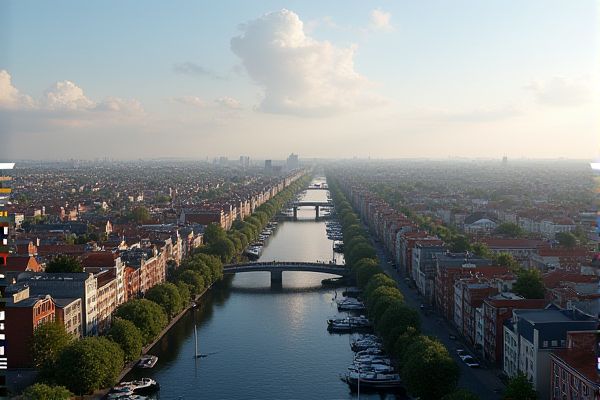
Weather and climate in Denmark: Mild, temperate climate year-round. Frequent rain and overcast skies. Winter months can be windy. Snow is rare but possible. Summer temperatures are mild. Coastal regions experience milder winters. The daylight varies significantly by season. Humidity levels are generally high. Fog common in late autumn. Rapid weather changes possible.
Mild, temperate climate year-round.
Denmark boasts a mild, temperate climate year-round, which is greatly influenced by the warm Gulf Stream. It experiences four distinct seasons: mild springs, warm summers, rainy autumns, and cold winters. Nonetheless, its maritime location ensures that Denmark is generally milder than other Scandinavian countries. The climate is characterized by cool to cold winters and mild summers, with average temperatures ranging from 0°C (32°F) in February to 15.7°C (60°F) in August. For more details on what makes the climate of Denmark so unique, visit the Visit Denmark website.
Frequent rain and overcast skies.
Denmark experiences frequent rain throughout the year, with an average annual rainfall of 61 cm, and the autumn season from September to November is particularly rainy and overcast. The west coast receives more rainfall due to prevailing westerly winds. In particular, the region of AEroskobing is known for its overcast skies, especially in December, where the sky is overcast or mostly cloudy 70% of the time. Rain falls consistently throughout the year, making Denmark a place where the wettest season unfolds during the autumn months.
Winter months can be windy.
Winter in Denmark is cold and often windy, especially on the western coast and small islands, with average temperatures just above freezing and frequent, though not abundant, precipitation. The sky is often overcast, and intense winds are common, with temperatures sometimes dropping below freezing due to easterly currents. For more detailed information about Denmark's climate, you can visit the website Climates To Travel to explore further.
Snow is rare but possible.
Snow in Denmark is rare but possible, particularly during the winter months from December to March. During this period, the country experiences its coldest temperatures, with February being the coldest month with a mean temperature of 0.0°C (32°F). For more information on Denmark's winter climate and other seasonal highlights, you can explore the comprehensive resources available on the official Visit Denmark website.
Summer temperatures are mild.
In Denmark, summer temperatures are mild, with highs in July and August around 22°C (72°F) in cities like Copenhagen, and nights remaining cool at about 13-15°C (55-59°F). The temperatures are rarely hot, with the highest recorded temperatures usually not exceeding 30°C (86°F) along the coasts and up to 34-35°C (93-95°F) in inland areas. For more detailed information on the climate specifics, visiting Climates to Travel would provide additional insights into Denmark's unique weather patterns.
Coastal regions experience milder winters.
In Denmark, coastal regions, particularly Western Denmark, experience milder winters due to the moderating influence of the Gulf Stream and the North Atlantic Ocean, resulting in cooler summers and relatively high levels of precipitation throughout the year. This temperate oceanic climate allows for outdoor activities like hiking and cycling in the mild summers and winter sports in the cool winters. For more detailed information on these climatic patterns, visit the Climate Zones of Denmark page.
The daylight varies significantly by season.
Denmark experiences significant variations in daylight hours by season, with summer days offering over 17 hours of sunlight, as sunrise occurs around 4:30 a.m. and sunset around 10:00 p.m. Conversely, winter days are much shorter, with only about 7 hours of sunlight, as sunrise happens around 8:45 a.m. and sunset around 3:45 p.m. This dramatic difference in daylight can significantly influence daily life and activities. For more detailed insights into Denmark's seasonal variations, visit the Detailed Weather Guide.
Humidity levels are generally high.
In Denmark, particularly in Copenhagen, humidity levels are generally high, averaging around 79% throughout the year, with the highest humidity in January at 86% and the lowest in May at 72%. For more detailed information, you can visit the Weather and Climate website to explore average monthly humidity in this region.
Fog common in late autumn.
In late autumn, Denmark is characterized by rainy and overcast weather, creating conditions that could lead to fog. While fog is not specifically highlighted as a common phenomenon during this season, the prevailing damp and cloudy atmosphere inherently supports its occurrence. Explore further details on Denmark's autumn climate by visiting the official VisitDenmark website for comprehensive insights.
Rapid weather changes possible.
Denmark experiences rapid weather changes, particularly with increased precipitation and extreme events like cloudbursts and heatwaves, which have become more frequent due to climate change, leading to flooding and other severe weather impacts. The country's temperate climate, influenced by its coastal location, also contributes to unstable and variable weather conditions. For more insights on these developments, the article on Climate Adaptation Plans provides a comprehensive analysis of the ongoing challenges Denmark faces in addressing these environmental changes.
